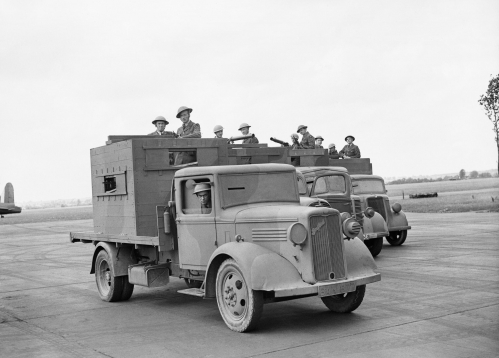|
|
|
Britain
Armadillo MkIII |
| The Armadillo MkIII was a Specialised vehicle designed in 1940, manufactured by Bedford Vehicles, it was based on the 4 x 2 drive Bedford 1.5 ton lorry chassis chassis and was in use from 1940 to 1941. |
|
|
|

Stanley Arthur Devon, Public domain, via Wikimedia Commons
|
| General Details (Specialised) |
|---|
| | Specifications | | Operational Date(s) | 1940 - 1941 | | Quantity Produced | 877 | | Weight | 6.5 tonne | | Crew | 5 | | M.G's small | 1 | | M.G's large(>10mm) | n/a | | Length | 6.22 mtr | | Width | 2.18 mtr | | Height | 3.09 mtr | | Engine Details/Performance | | Max Road Speed | 40 mph | | Max Cross Country Speed | 8 mph | | Range Road | 280 miles | | Range Cross Country | 56 miles | | Fuel Type | Petrol | | Fuel Capacity | 32 gal | | Horse Power | 72 hp | | Power/Weight | 11 hp/tonne | | | General Information | The Armadillo MkIII was a Specialised vehicle designed in 1940, manufactured by Bedford Vehicles, it was based on the 4 x 2 drive Bedford 1.5 ton lorry chassis chassis and was in use from 1940 to 1941.
The vehicle was powered by Bedford '3.6 L' petrol powerplant producing 72 HP which could drive the vehicle on roads at up to 40 mph with a range of about 280 miles before refuelling. Its cross country performance was adequate providing a max speed of about 8 mph and a range of about 56 miles.
It was armed with 1 light machine gun , a Lewis Gun. Its main armament consisted of a 37mm COW gun which could penetrate 28 mm of flat plate at 400 metres
The Armadillo Mark III was produced in Britain during 1941 and intended as a defense against the threat of invasion(Home Guard) or paratroop attacks on airfields(RAF).
Based on the standard Bedford 1.5 ton lorry chassis, it comprised a two layer wooden fighting compartment with a 6 inch gap containing a layer of gravel to protect from bullets with a driver's cab protected by mild steel plates.
For all intents and purposes it was a mobile pillbox. | |
| | Turret | | Front | n/a | | Side | n/a | | Rear | n/a | | Top | n/a |
| | Superstructure | | Front | n/a | | Side | n/a | | Rear | n/a | | Top | n/a |
|
| Hull | | Front | n/a | | Side | n/a | | Rear | n/a | | Top | n/a |
| | Armour (x)mm @ (y)° (Effective mm @ 0°) |
| | | Weapon Details |
|---|
|
|
37mm COW gun
(Machine Gun) |
 |
|
| Ammunition Details |
|---|
| Name/Id |
Calibre Weight MVelocity |
Explosive Content |
|
37x190R HE
(HE High Explosive)
|
37mm 0.65Kg 594M/Sec | ≈0.098Kg explosive |
| Range(Mtr) | 1000 | 2000 | 3000 | 4000 | 5000 | 6000 | 7000 | 8000 |
|---|
| Flight Time(Secs) |
2.31 |
7.34 |
|
|
|
|
|
|
|---|
| Direct Fire |
| Range(Mtr) | 100 | 200 | 400 | 800 | 1200 | 1600 | 2000 | 2400 |
|---|
| Flight Time(Secs) |
0.17 |
0.36 |
0.76 |
1.72 |
3 |
4.75 |
7.34 |
11.56 |
|---|
| Hit Probability(%) |
98 |
98 |
98 |
77 |
29 |
8 |
2 |
0 |
|---|
| Blast/Fragmentation Effects |
| Burst radius Infantry in open 99% kill | 2 mtr |
Burst radius Infantry in open 66% kill | 5 mtr |
|---|
| Burst radius Infantry in open 33% kill | 13 mtr |
Armour Penetration inc roof at 1 mtr | 0 mm |
|---|
| An explosion within 2 mtr of infantry in the open will cause 99% casualties - lethal. |
| An explosion within 5 mtr of infantry in the open will cause > 66% casualties and could damage some AFV's. |
| An explosion within 13 mtr of infantry in the open will cause 33% casualties. |
| The blast effect of this shell exploding within 1 mtr of an armoured vehicle will not cause any significant armour damage. |
| Weapon Details |
|---|
|
Lewis Gun
(Machine Gun) |
 |
|
| Ammunition Details |
|---|
| Name/Id |
Calibre Weight MVelocity |
Explosive Content |
|
Standard british .303 round - HPBT
(BALL Standard Small Arms)
|
7.70mm 0.01Kg 761M/Sec | |
| Range(Mtr) | 100 | 200 | 400 | 800 | 1200 | 1600 | 2000 | 2400 |
|---|
| Flight Time(Secs) |
0.17 |
|
|
|
|
|
|
|
|---|
| Penetration(mm@30°) |
1 |
|
|
|
|
|
|
|
|---|
| Penetration(mm@0°) |
2 |
|
|
|
|
|
|
|
|---|
| Hit Probability(%) |
98 |
|
|
|
|
|
|
|
|---|
|
Standard british .303 round
(BALL Standard Small Arms)
|
7.70mm 0.017Kg 783M/Sec | |
| Range(Mtr) | 100 | 200 | 400 | 800 | 1200 | 1600 | 2000 | 2400 |
|---|
| Flight Time(Secs) |
0.15 |
|
|
|
|
|
|
|
|---|
| Penetration(mm@30°) |
4 |
|
|
|
|
|
|
|
|---|
| Penetration(mm@0°) |
5 |
|
|
|
|
|
|
|
|---|
| Hit Probability(%) |
98 |
|
|
|
|
|
|
|
|---|
|
Hit probability is based on a static 2 x 2.4 metre panel at 0 degrees(vertical) at the range specified.
The data that has been used to create these records has come from Wikipedia, The Lone Sentry, The Bundes Archive
and numerous books and websites that have provided the detailed information that has not been available anywhere else. The
information we use to calculate the penetration tables, flight times and the hit probability comes from the Gun Calibre,
the Shell Mass(Kg) and the muzzle velocity, plus range reductions to allow for gravity and wind resistance. This calculation
originally came from a pre-war Krupp calculation which has been modified, and seems to fit the actual test results.
 
© WWIITanks 1980-2025
If you have any information, or comments on our site,
please E-Mail Simon at
wwiitanks@villagenet.co.uk
Page Last Updated: 2025-01-01
|
|
|
|
|
|
|


